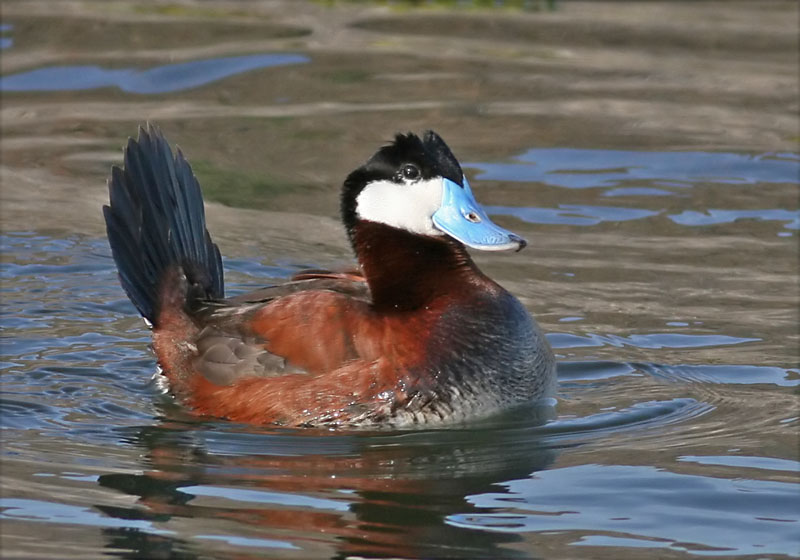
Ruddy duck(Oxyura jamaicensis)
Phylum —chordata
Class — aves
Order — anseriformes
Family — anatidae
Genus –oxyura
Appearance
These are small, compact ducks with stout, scoop-shaped bills, and long, stiff tails they often hold cocked upward. They have slightly peaked heads and fairly short, thick necks. Male ruddy ducks have blackish caps that contrast with bright white cheeks. In summer, they have rich chestnut bodies with bright blue bills. In winter, they are dull gray-brown above and paler below with dull gray bills. Females and first-year males are brownish, somewhat like winter males but with a blurry stripe across the pale cheek patch. In flight, ruddy ducks show solidly dark tops of the wings.
Length – 340-430 mm (13,5-17 in), weight – 560 g, wingspan – 470 mm (18,5 in).
Habitat
There are three subspecies:
- O. j. jamaicensis (nominate subspecies) - North America including West Indies.
- O. j. andina - central Colombia.
- O. j. ferruginea - southern Colombia south to Chile.
These ducks migrate mostly at night, in small flocks. Migration extends over considerable period in both spring and fall. Populations in Caribbean and South America may be permanent residents.
Behavior
Ruddy ducks are clumsy on land, their legs are set far back on the body, making it difficult for them to walk. The same placement of their legs makes them exceptionally fast and agile in the water. They can dive or sink into the water with little effort. While diving, the feet paddle simultaneously and wings remain closed. To take flight these ducks must beat their wings rapidly and run along the surface of the water. Ruddy ducks fly just above the water, even during migration when they travel in medium to large sized flocks at night to their summer breeding grounds.
These ducks are usually found alone, in pairs, or in small groups of eight to twelve. They generally don't flock with other kinds of ducks or geese.
Diet
Ruddy ducks dive to feed on aquatic invertebrates, especially midge larvae. They feed most actively at night.
Reproduction
Ruddy ducks breed seasonally. They migrate to breeding grounds in late winter. When they get to their breeding areas males begin to perform courtship displays.
Ruddy ducks breed in spring and summer months, from May to August. When they arrive on the breeding grounds, females construct nests of aquatic plants just above the water level. They often build a dome over the nest to hide it from predators. About 4 weeks after arriving at the breeding grounds, females are ready to nest. Sometimes, though, females are ready to lay eggs before they have finished their own nests and they may simply lay eggs in unprotected areas that hatch after 23 to 26 days. Young ruddy ducks are well developed when they hatch. They stay in the nest 1 day after hatching and then are led away from the nest and into the water. At this point young ruddy ducks can dive to find food and can defend themselves. Parents abandon their young 20 to 30 days after hatching, but it takes another 20 to 35 days after that for the young ruddy ducks to learn how to fly.
Female ruddy ducks construct and cover nests for their young, invest energy in making the eggs, and do all of the incubation of eggs. They also aggressively protect their young for several weeks after they hatch. Male ruddy ducks don't care for their young. They may remain near the female during incubation and after the young hatch, but they don't make any effort to protect or feed them.
Lifespan is 13 years in the wild and about 2.5 years in captivity.
In captivity
In captivity, these little ducks often live in habitats with several other species of waterfowl. They are relatively aggressive, especially while breeding, and they typically chase their neighbors around when they get too close to their nests. Because of this, aviaries should be adequately large enough for all of the waterfowl and other birds to have their own space.
Enclosures should also have plenty of water features to forage in. Additional nutrition, in the form of vegetables and pelleted duck feed, helps ensure these ducks receive all the proper vitamins and minerals.
 Russian
Russian
 English
English
























